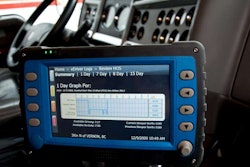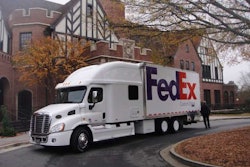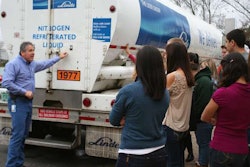
If Kraft is right, implementation of the full mandate that was written into this year’s MAP-21 highway bill is a ways off. At the beginning of the talk, he revised his speculative forecast for the proposed rule’s likely release in March 2013, which we reported on in August. He said that, realistically, a proposed rule would be likely by “mid-2013. There’s so much work to do on the technical standards.”
A final rule? “Probably late 2014,” he said, though the “mandate legislation [in MAP-21] said a final rule should be in by October 2013, but … I don’t think that’s a realistic timeline.”
Full required implementation industrywide, Kraft noted, will be “at least four-five years after the final rule to get it all rolled out.”
Find highlights from the online seminar following. Fleet participants on the call were as follows:
**Allen Lowry, safety director for Central Refrigerated Service, based in Utah
**Vincent J. Dinino Jr., fleet safety manager for Emerson Express Co. of Rochester, N.Y., with 80 trucks or so.
‘MYTHS’
1. EOBRs are a threat to driver privacy with GPS tracking and log data details that may be misused by law enforcement.
Kraft: “First of all, in MAP-21, it limits EOBR data use to law enforcement and inspections. Secondly, the systems we’ve implemented have good security and access control — only accessible on a need-to-know basis and used for compliance management and things of that nature.”
Lowry: “Originally, we implemented [EOBRs] in 2008 in preparation for [the FMCSA’s Compliance, Safety, Accountability program]. A few drivers had some concerns, but they were quickly addressed.
Dinino: Emerson implemented EOBRs more recently. “Originally, there was some reluctance, certainly. That myth, if you will, was dispelled quickly once the system was instituted and became quite user-friendly and protective of our drivers.” Dinino noted many of his drivers view the electronic log as a sort of “safety net” around them against pushing too hard to run all available hours.
2. EOBRs are a tool for driver harassment.
Kraft: Kraft made particular note of the verdict handed down last year that forced FMCSA to vacate the previous limited mandate for hours-noncompliant carriers to use EOBRs as remediation. That verdict “wasn’t really about driver harassment,” he said. What was it about? “FMCSA’s failure to address harassment as a potential problem,” he said.
Dinino: “We have a company policy in place … that first of all if the driver, whether he has hours available or not, if he can’t finish the duration of the trip, he will not be forced into that dispatch. It does take some preplanning on the driver’s behalf — if you have an eight-hour drive, you need to look to get there with some time left rather than having to back yourself up like you used to be able to.”
Lowry: “There’s a lot of guys that were on paper originally that just didn’t understand the hours of service – operations would spend a lot of time having drivers faxing logs in and harassment came more with the paper than the electronic logs. Under [regulation] 392.3 – a driver can’t drive while ill or fatigued. That protects the driver in that aspect. Dispatch has the responsibility to preplan and determine what a driver can and cannot do.”
3. There is no safety benefit associated with use of EOBRs.
Lowry: “When drivers were on paper logs, it was amazing to me [that] they would come home and seem like they were dead tired — there have been multiple times I’d have a driver on a personal basis … say that when they come home now, with the EOBRs, because it makes them take a 10-hour break, they can come home and function. We’ve found that with litigation and other issues … it also made it so much easier on our legal and safety departments. We knew we had a much more rested driver in that truck. They are required to take that full 10-hour break.
“Something we didn’t expect was the change in the attitude of the driver and the way that he would communicate with dispatch. Now the staff really takes what the driver says as word. They believe him, and attitudes overall have improved.”
Dinino: Well, first of all, it certainly has helped diminish any pending log violations — and number two, at roadside checks the driver is more than welcoming the officials to look at their logs, whether they are asked to perform their hours of service recap or have the officer do it. Further, we’ve used the EOBR situation to enhance our critical event reporting — we use that regularly for hard-braking events, stability control and lane departure issues. … [Generally, an EOBR] really takes the onus off the driver in putting them where they say they are and putting them in persptective of hours available. The fudge factor is now gone.”
Kraft: “In many cases, [systems in place today] were implemented for other things than hours of service. Low-cost systems are available today. Earlier, the technology wasn’t quite there. In today’s world, … an electronic log system with other features can be under $500 or on a monthly basis for $35 dollars with no up-front costs.”
Lowry: “We look at the return aspect on it. We were spending upward of $50,000 on log scanning and storage per year. $90,000 in log books. $10,000 in other expenses. The greatest benefit is the ability to utilize hours in back-office integration — evaluating loads as far as hours of service goes to find the best-suited driver. It’s difficult to quanity that.”
Dinino: “We do in fact see a return, as Allen’s operation. Before the purchase was made there was a cost study in place — [return-on-investment] would be much greater than the outlay for the equipment, and then with dispatch having total transparency… Again, along those lines, we’ve taken advantage of some enhancements — electronic inspection reports fire off an e-mail to our shop immediately [noting problems]. That’s helped our maintenance cost go down preemptively.”
5. EOBR data is easily manipulated.
Kraft: “Carriers are accountable for log accuracy. With these electronic records, it’s hard to make the data go away, and enforcement knows what to look for. When you make edits, you can’t just make things disappear, and you have six months of data.”
Dinino: “We do monitor and run reports regularly. Any log violations, we do one-on-one meetings with the drivers. The other part is that we nor they manipulate drivers’ hours. And drivers do not have a propensity to falsify those hours. We’ve had very little pushback with regard to propensity for manipulation of data.”
Lowry: You know, initially on paper logs, there was anywhere from a 10- to 15-day delay before a driver turned the logs in. Almost 30 days being the eight ball on auditing logs. EOBRs give us real-time ability. If the log goes into violation, we can address it immediately, before it turns into a full 30 days’ worth of problems.”
6. EOBRs are not enforceable — roadside officers will just “wave you through.”
Kraft: Kraft referenced CVSA’s North American inspectors’ championships, where he says he saw firsthand how some jurisdiction are “getting impressive with the knowledge inspectors have of these systems. The idea that you’re just going to get waved through isn’t there anymore. And inspection screening is getting much better — carriers with low violation rates are just not going to be screened.” All the same, carriers who’ve implemented EOBRs, he added, have an advantage over others in this day and age.
Lowry: “We here in Utah have a top-hands competition the highway patrol competes in, and then they do it on a national level. They’ve invited me the last two years to teach them about EOBRs – what the myths are and how the systems actually function. They are required to be recertified yearly. Local folks are getting more trained on how to read the EOBRs – on the different types, they stay up to date. One benefit I’ve found is that you don’t have worry about when a driver arrives having them on the right duty status. It does it automatically. Enforcement can get everything at a quick glance, too.”
Dinino: “Certainly, our numbers have been reduced in terms of inspections and violations – a direct result of the EOBRs. What it does do is make an awareness available to us [on where] to heavily concentrate our maintenance issues to have a clean inspection when we are inspected. While the inspection rate has dropped, the violation rate has dropped exponentially.”
Kraft: “Really, they’re electronic tools — information tools to help carriers and drivers working together to manage compliance. It’s less the enforcement aspect than it’s an information tool for preventive alerts.”
Lowry: “With CSA and the way customers are looking at that … it’s a huge deal. I was looking back at the reason we went to EOBRs: it was because of a DOT audit. [We were looking for] ways to address issues in real time. … This makes it so much easier instead of having to worry about a 30-day lag.”
Dinino: “Not only manage compliance but equipment as well — it becomes a virtual office for the driver for communication with the maintenance office dispatch and employer dispatch as well.”
So… thoughts?
For more views on EOBRs, here are a few past posts, all within the last year:
10 Problems with EOBRs
Does the EOBR mandate have another problem?
Hours, EOBRs: Adapt or fight?










